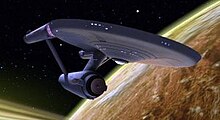| USS Enterprise | |
|---|---|
| Star Trek vehicle | |
 USS Enterprise (NCC-1701) as it appeared in promotional material for the remastered original Star Trek series | |
| First appearance |
|
| Last appearance |
|
| Created by | Matt Jefferies |
| Information | |
| Affiliation | United Federation of Planets Starfleet |
| Launched | 2245[1] |
| Captain | Robert April Christopher Pike James T. Kirk Willard Decker Spock |
| Auxiliary vehicles | Shuttlecraft |
| General characteristics | |
| Class | Constitution[1] |
| Registry | NCC-1701 |
| Armaments | Phasers Photon torpedoes |
| Defenses | Deflector shields |
| Propulsion | Thrusters Impulse drive Warp drive |
| Power | Matter/antimatter reaction |
| Mass | 190,000 metric tons (210,000 short tons)[2][3] |
| Length | 288.6 metres (947 ft)[2][3] |
| Width | 127.1 metres (417 ft)[2][3] |
| Height | 72.6 metres (238 ft)[2][3] |
USS Enterprise (NCC-1701) is a starship in the Star Trek media franchise. It is the main setting of the original Star Trek television series (1966–69), and it is depicted in films, other television series, spin-off fiction, products, and fan-created media. Under the command of Captain James T. Kirk, the Enterprise carries its crew on a mission "to explore strange, new worlds; to seek out new life and new civilizations; to boldly go where no man has gone before." Star Trek: Strange New Worlds (2022–present) depicts the Enterprise under the command of Kirk's predecessor, Captain Christopher Pike.
Matt Jefferies designed the Enterprise for television, and its core components – a flying saucer-shaped primary hull, two offset engine nacelles, and a cylindrical secondary hull – persisted across several television and film redesigns. The vessel influenced the design of subsequent franchise spacecraft, and the model filmed for the original Star Trek TV series has been on display for decades at the National Air and Space Museum.
Initially a vision of the potential for human spaceflight, the Enterprise became a popular culture icon. The Enterprise has repeatedly been identified as one of the best-designed and most influential science fiction spacecraft.
- ^ a b "Enterprise, U.S.S." startrek.com. Retrieved August 26, 2018.
- ^ a b c d Franz Joseph Designs (1975). Star Trek Blueprints: General Plans, Constitution Class, U.S.S. Enterprise (2nd ed.). Ballantine Books. p. 4. Archived from the original on December 6, 2006.
- ^ a b c d Robinson & Riley 2010, p. 37.